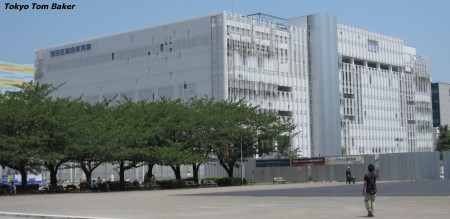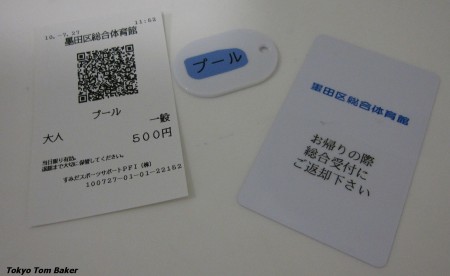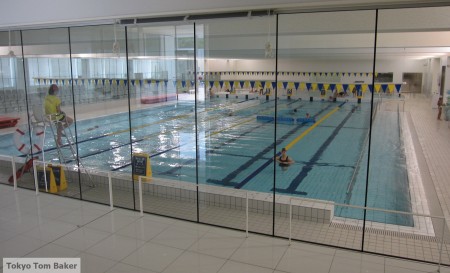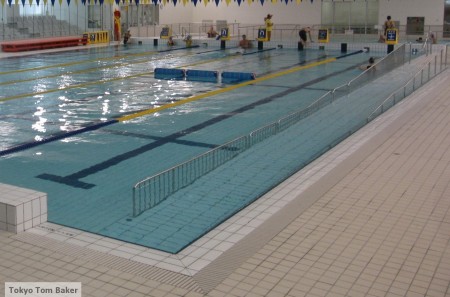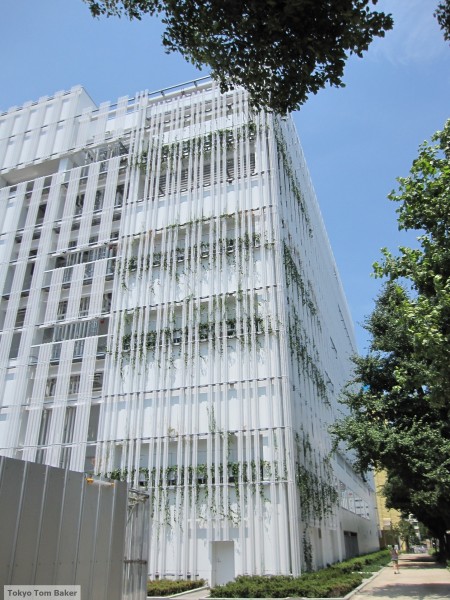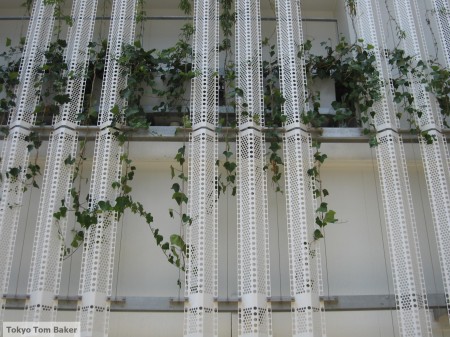One hundred and eighty thousand people showed up the other weekend for the grand reopening of the giant Mitsukoshi department store in Ginza, Tokyo. I was one of them, but I was not among the 2,000 who were already waiting on the sidewalk when the doors opened 15 minutes early at 9:45 a.m. on Saturday, Sept. 11.
The new store is so gigantic – 36,000 square meters, which is 50 percent larger than its old incarnation – that it easily swallowed the big crowd. By the time I ambled in at 10:15, I was able to move around freely, enjoying a fair amount of elbow room.
The expansion was accomplished by attaching the original nine-story building, which stands at Ginza’s main intersection, to a new 12-story building at the other end of the same block. You can see the original street-corner entrance of the old building near the center of the photo below, with the tall new annex visible further back and to the right.

And here’s a street-level view of the new annex at night:
To see what’s inside, visit the store’s site here, and click on the floor you are interested in.
Most of the space in the building is given over to high-end clothing, jewelry and accessories – Prada, Gucci, Vivienne Tam, Moschino, Burberry, Tom Ford, Giorgio Armani, Tiffany, Bulgari, you get the idea – but I breezed past much of that to focus on Mitsukoshi’s culinary and architectural details.
However, one place I did have to stop in the clothing areas was at the Atelier Longhouse / Piro Racing boutique on the fourth floor, right next to Givenchy, which in turn is next to Celine. This shop is run by Hirokazu Nagaya, pictured below, and his mother Emiko Nagaya.

Hirokazu is a former racecar driver who uses a wheelchair as a result of a crash. He is now in the clothing business, focusing on good-looking garments for people in wheelchairs, who tend to have specialized tailoring needs. You can learn more about him at his Japanese-language website here or in an English-language magazine article that I interviewed him for last year. (It will appear in a future blog entry, so watch this space.)
Turning my attention to culinary topics, I headed for the upper floors of the new building, where there are restaurants representing the cuisines of several nations, as well as Japanese specialties such as freshly made noodles and Okinawan cuisine. As I stepped off the escalator, I found a ceremony in progress at a noodle shop called Hakone Akatsukian. After a moment’s hesitation, I took out my camera and made a video of the tail end of it:
Later, I returned and found the apparent proprietor making noodles behind a glass window, so I made another brief video:
It began to look as if the noodle-making process was going to take some time, so I turned off my camera and went to see what else there was to look at. (A real video journalist would have begun filming the ceremony immediately, and would have filmed the noodle-making to its end, but I’m figuring this out as I go.)
Hakone Akatsukian appears to be a new branch of a place that really does exist in Hakone, a famous hot spring resort area near Mt. Fuji. You can read about the older noodle shop in Japanese here or here, and see a mention of their Roppongi branch in The Wall Street Journal here.
Now that I work in Ginza, I plan to visit several of Mitsukoshi’s restaurants for lunch in the future, but on my first day the only edibles I purchased were in the Jean-Paul Hevin chocolate shop on the ground floor.

At front right in this photo is the Longchamp Chocolat Lait (630 yen), which the multilingual young lady behind the counter recommended to me as the sweetest item in the shop. As photographed here, it is broken open so you can see the fluffy interior, which seems to consist mainly of frothy whipped butter. Behind that is a slice of Matcha cake (630 yen), the layers of which combine soft and crunchy textures, and in which yuzu citrus is the most prominent flavor even though the cake is named for the green tea it also contains. Next to that is a dark chocolate Guayaquil cake (578 yen), which the shop lady pointed out when I asked her what would be the most bitter cake as a contrast to the sweet one. “Bitter” turned out not to be the right word for this cake, as there was nothing harsh about it, but it definitely was not sweet – a welcome contrast to the stratospheric richness of the other items. Finally, in front, is a sugar-dusted Macaron Chocolat al’Ancienne (662 yen), which begins as a simple macaroon (Hevin’s signature item) but then is covered in several layers of other sweet stuff until it reaches a prodigious size. You can study more of his confections here.
Shortly after buying these items, I found some other macaroons in a different part of the store:

But these macaroons are not edible. Instead, they are cute accessories that may tie in to Mitsukoshi’s reported attempts to make its new incarnation more attractive to young women, who in recent years had come to view the store as place for older women to go.
And speaking of cute, something I wish I had space for in my kitchen is the nabe pot shaped like a pumpkin in the middle of this photo in the kitchenware department:

As for the building itself, the new annex is full of eating areas and rest areas that occupy relatively narrow slivers of floor space but are characterized by high ceilings and large windows that make them feel spacious by filling them with airiness and natural light.




The nicest part of the remodeled store, though, is how the upper floors of the new part of the building open out onto the green landscaped roof of the shorter old building.


I was pleased to see that the roof area includes a green curtain of the kind I described in reference to the Sumida Ward Gym here.

And finally, nestled into the base of the green curtain is a small religious area featuring a rather massive Jizo statue that was reportedly unearthed nearby during the Meiji era.



